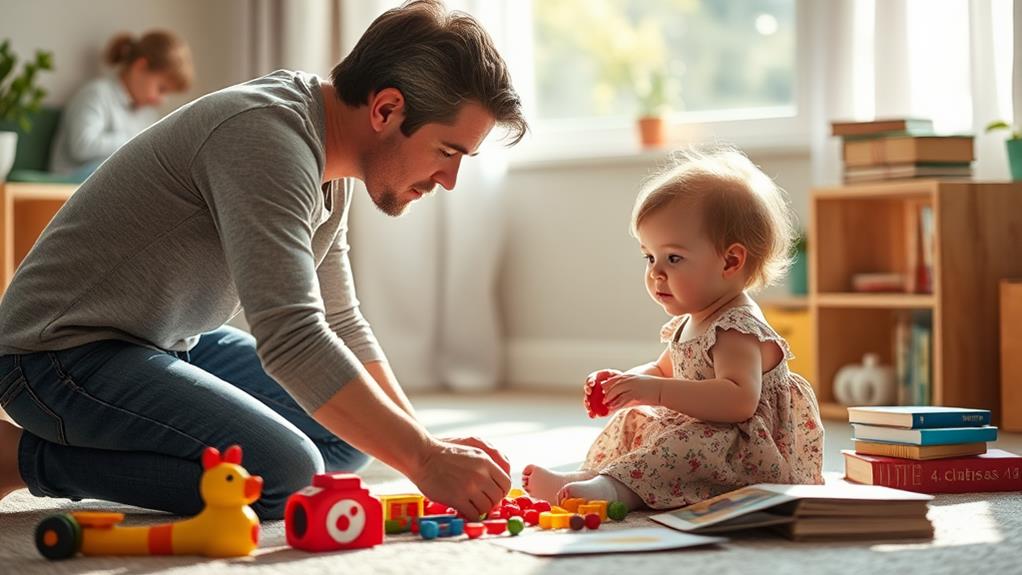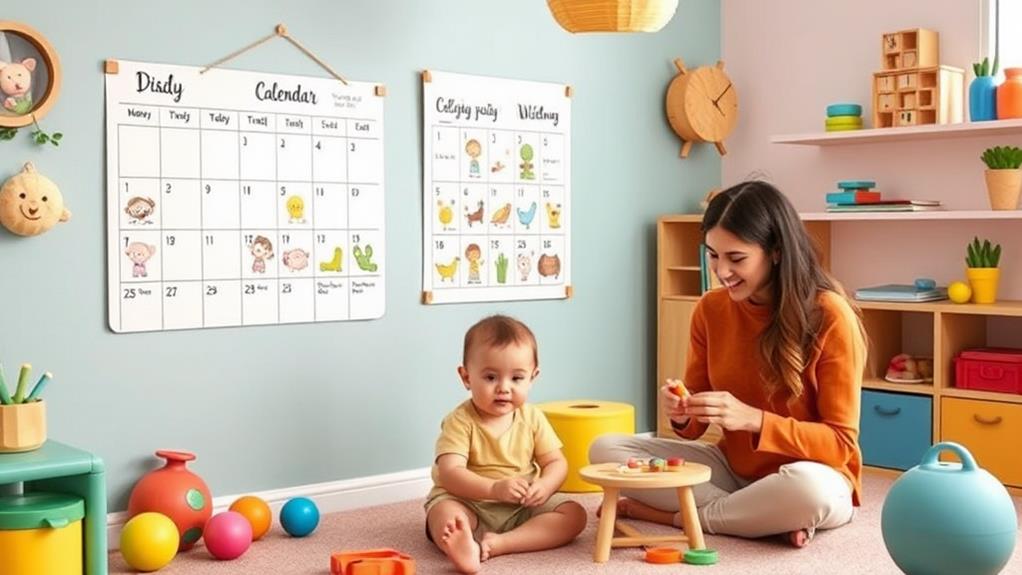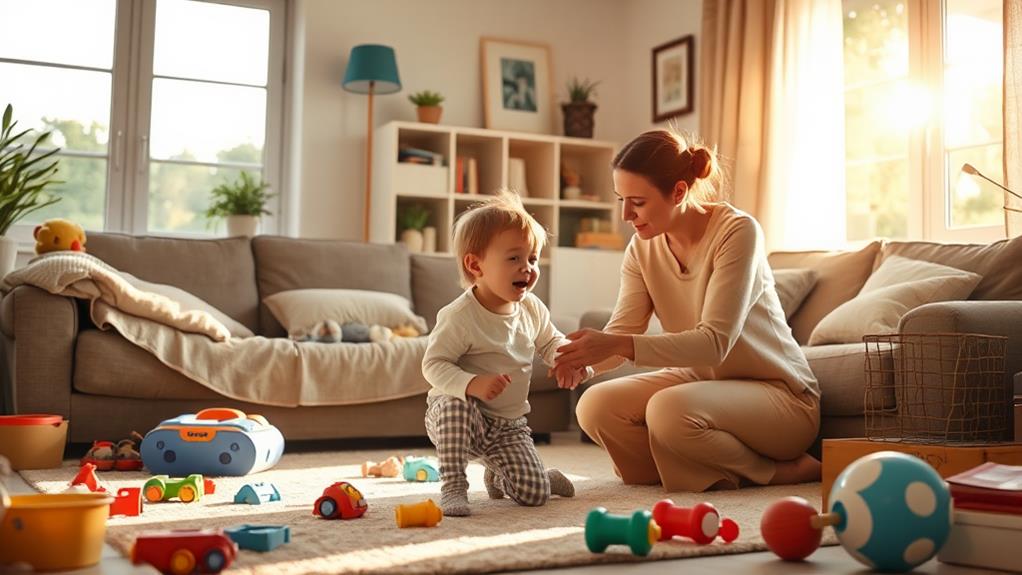How to Get Your Toddler to Listen Without Yelling
Getting your toddler to listen without resorting to yelling can feel like a daunting task. You might find that simple language and clear instructions can make a difference, but it's also about understanding their developmental stage. Establishing consistent routines and expectations provides security, while engaging in active listening shows you value their thoughts. However, the key might lie in how you communicate and connect with them. Want to discover more effective strategies that can transform your interactions?
Understand Toddler Development

To effectively communicate with your toddler, it's crucial to grasp their developmental stages. At this age, toddlers are exploring their world and developing independence, which can make them seem defiant or uncooperative at times. Understanding their cognitive and emotional growth helps you tailor your approach to fit their needs.
For example, toddlers around two to three years old are learning to express themselves, but their language skills are still developing. They may not fully understand complex instructions or reasoning, so keep your language simple and direct. Use short sentences and clear words to convey your messages.
Also, remember that toddlers are highly emotional. They might feel overwhelmed by new experiences or changes in routine, leading to tantrums or stubbornness. Acknowledging their feelings and providing comfort can go a long way in helping them feel secure.
Establish Clear Expectations
Setting clear expectations helps toddlers understand what's expected of them and reduces confusion. When you set specific guidelines, it gives your little one a roadmap to follow throughout the day.
Try to break down tasks into simple, manageable steps. For example, instead of saying, "Clean your room," you might say, "Please put your toys in the bin and your books on the shelf." This clarity makes it easier for them to grasp what you want.
Additionally, use consistent language when explaining rules. If you say, "No jumping on the couch," make sure to stick to it. Consistency helps reinforce your message and builds a sense of security.
You might even create a visual chart that outlines daily expectations, like brushing teeth or getting dressed. This can be a fun way for your toddler to see what's coming next.
Use Positive Reinforcement

You can also create a reward chart.
Every time your toddler listens well, let them add a sticker to the chart.
Once they collect a certain number of stickers, treat them to a fun outing or a special treat.
This method not only motivates them but also fosters a sense of accomplishment.
Get Down to Their Level
Getting down to your toddler's level can make a significant difference in how they respond to you. When you kneel or sit beside them, you create a connection that feels more personal and less intimidating. This approach allows you to engage their attention more effectively.
Toddlers are naturally curious and often overwhelmed by the adult world. By lowering yourself, you're showing that you understand their perspective and value their feelings.
This physical closeness encourages them to focus on what you're saying. It's easier for them to absorb your words when you're eye-to-eye, rather than towering over them. Plus, it's a great opportunity to read their body language—watch for signs of understanding or confusion.
When you're at their level, you can also use gentle touch or a comforting smile, which helps reinforce your message. It sends a signal that you're approachable and ready to listen, making them feel safe and secure.
This simple act can transform a potentially frustrating interaction into a more positive experience. So, the next time you need to communicate with your toddler, remember to get down to their level. You might be surprised at the difference it makes!
Use Simple Language

When talking to your toddler, using simple language is key to effective communication. Toddlers thrive on clarity, so it's important to keep your words short and straightforward. Instead of saying, "Please refrain from running indoors," try saying, "No running inside." This makes it easier for them to understand what you want.
Use familiar words and phrases that they hear often. For instance, instead of saying, "Let's engage in a cleanup," say, "Time to clean up!" This way, they can grasp the meaning without getting confused. Repetition is also your friend. If you consistently use the same phrases, they'll start to recognize and respond to them more quickly.
Additionally, keep your sentences concise. Long explanations can overwhelm your little one, making it harder for them to follow what you're saying. If you need to explain something, break it down into small, manageable steps.
For example, "Put your toys away. Then, we can go outside." This approach not only aids comprehension but also sets clear expectations, making it more likely they'll listen and respond positively.
Offer Choices and Autonomy
Offering choices and autonomy to your toddler can significantly boost their willingness to listen. When you give your little one options, they feel more in control and valued. Instead of saying, "Put on your shoes," try asking, "Do you want to wear the red shoes or the blue ones?" This simple shift gives them a sense of agency and often leads to better cooperation.
It's essential to keep the choices limited and age-appropriate. Too many options can overwhelm them, while just two or three can empower them to make decisions. You might also consider offering choices in daily routines, like picking out their clothes or deciding between a snack of apple slices or yogurt. These small decisions help your toddler feel involved in their day-to-day life.
Remember to celebrate their choices, even if it's not what you would've picked. This affirmation encourages them to continue making decisions.
When your toddler feels they've a stake in their daily activities, they're less likely to resist your guidance. So, embrace the power of choices, and watch how your toddler's willingness to listen grows!
Create a Routine

Establishing a consistent routine can work wonders for your toddler's listening skills. When you create a structured environment, your child knows what to expect, which helps reduce anxiety and confusion.
Start by setting specific times for daily activities, like mealtime, playtime, and bedtime. This predictability gives your toddler a sense of security, making them more likely to listen when you ask them to transition between tasks.
Involve your toddler in the process by letting them help create the routine. You might say, "What do you want to do after lunch?" This not only empowers them but also encourages them to listen to the routine you've established.
Use visual aids, like charts or pictures, to illustrate the daily schedule. Toddlers often respond well to visuals, making it easier for them to grasp what's coming next.
Remember to be flexible; routines can be adjusted as needed. If your toddler resists a particular activity, consider swapping it out for something they enjoy.
With a little patience and consistency, your toddler will start to respond better to your cues, making your interactions smoother and more enjoyable.
Practice Active Listening
Active listening is crucial for fostering effective communication with your toddler. When you engage with your child, make sure you're fully present. Put down your phone, turn off the TV, and give them your undivided attention. This shows them that what they say matters, building their confidence and trust in you.
As your toddler talks, nod and make eye contact to encourage them. Repeat back what they say in your own words to show you understand their feelings. For instance, if they say they're upset about a toy, you might say, "You're really sad because your toy broke." This validation helps them feel heard and understood.
It's also important to avoid interrupting. Let them express themselves completely before responding. This teaches them how to communicate effectively and helps you grasp their perspective.
If they struggle to find the right words, prompt them gently, but don't rush them.
Stay Calm and Composed

When your toddler is expressing their feelings, it's easy to get caught up in the moment, especially if they're upset or acting out. Staying calm and composed is crucial in these situations. When you maintain your cool, it sets a positive example for your child and helps diffuse their emotional intensity.
Take a deep breath, and remind yourself that this phase is just a part of their development. You might find it helpful to pause before responding. This brief moment allows you to gather your thoughts and respond more thoughtfully, rather than reactively.
If you're feeling overwhelmed, it's okay to step away for a moment, ensuring you don't lose your temper. Your child will notice your calm demeanor, which can encourage them to mirror it.
Additionally, using a soft tone when you talk can make a big difference. Toddlers often respond better to gentle voices than to raised ones. By staying calm, you're creating an environment where your toddler feels safe to express themselves, ultimately leading to better communication.
Model Good Communication
To foster effective communication, it's essential to model good communication habits yourself. Your toddler learns by watching you, so when you practice clear and respectful dialogue, they're more likely to mimic those same behaviors.
Start by using simple language and speaking at their eye level. This helps your child feel included and understood. Instead of just barking orders like "Get your shoes on!", try saying, "Can you please put on your shoes? We're going to the park!" This approach not only encourages cooperation but also teaches them how to ask for things politely.
When you communicate, be sure to listen actively. Show that you value what your toddler has to say by making eye contact and responding thoughtfully. This creates a safe space for them to express their thoughts and feelings.
Use positive reinforcement to acknowledge their efforts when they communicate well. For example, praise them when they use their words instead of whining. By modeling these good communication habits, you'll set a strong foundation for your child's listening skills and foster a more harmonious environment at home.














Post Comment